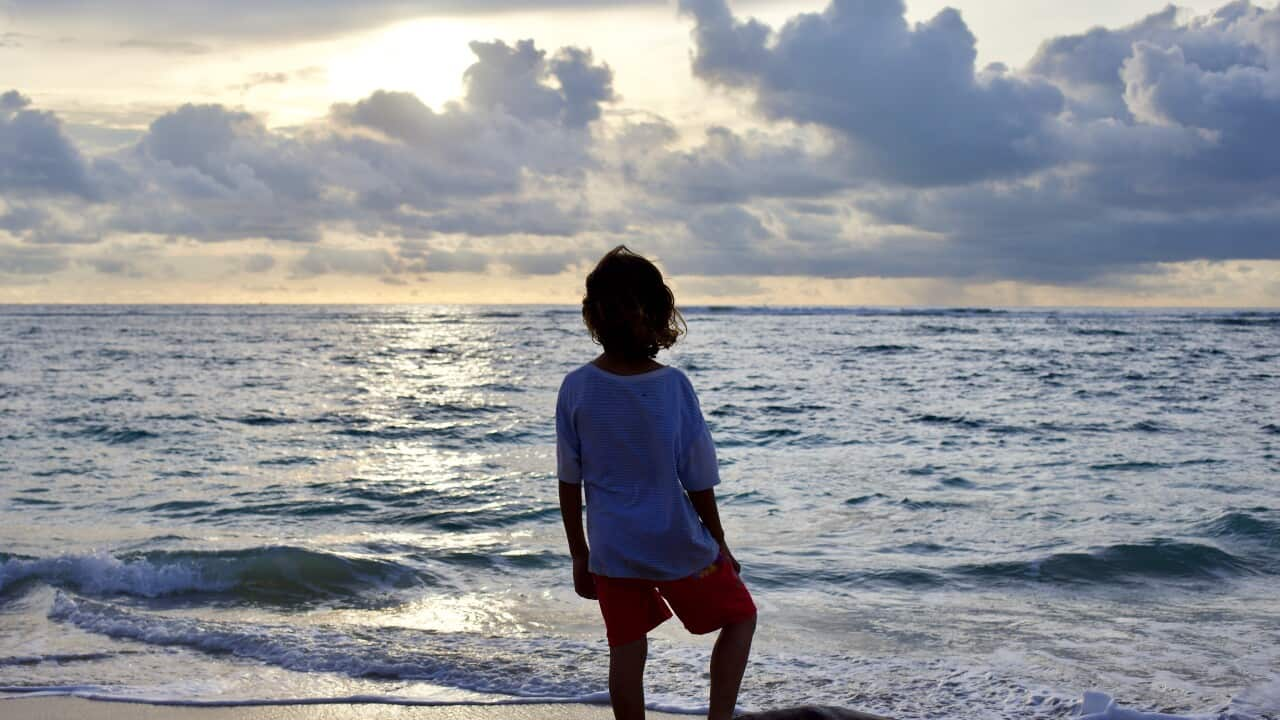“When I came out of my home, I saw the big wave. I ran immediately and didn’t turn back,” he tells SBS News.
The sound Razali heard was a 9.1 magnitude undersea earthquake, which struck 240km off the coast of Sumatra at around 8am on 26 December 2004.
I told everybody to get out and go up the mountain because a big wave is coming here, to our village.
Razali
It reached Aceh’s shore in just 15 minutes; the ‘wall of water’ bringing death and destruction to the densely populated province.

The United Nations estimates that at least 225,000 people died during the 2004 Indian Ocean Tsunami. Source: AFP / via Getty Images
Miracle birth
“When I arrived at the top of the mountain, it was 7pm. My son Mohamed was born just after. I had nothing, no midwife or anyone to help me.”

Nadiah and Razali with a photo of their son, who was born the night of the tsunami. Source: SBS News / Aaron Fernandes
When the water receded, the pair walked back down with their newborn son. It was a surreal experience, carrying life but surrounded by death.
“While we were walking to the emergency shelter, I saw so many dead bodies laid out on the road. I had to step over them; there were so many,” Razali says.
Mass graves
Around 60,000 people were killed in Aceh alone, as locals reported waves as high as 30m.

A mass grave in Aceh, where 3000 people were buried. Source: SBS News / Aaron Fernandes
The sheer number of deaths meant that tens of thousands were buried in mass graves, without ever being identified by their loved ones.
Around 3,000 are buried in its mass grave, which is looked after by a single volunteer named Sabari.

Sabari looks after the mass grave that contains around 3,000 bodies. Source: SBS News / Aaron Fernandes
Sabari survived the tsunami by clinging to a tree for 12 hours. He was with his wife in the moments before the wave struck, but she was swept away along with his daughter.
“The next day, locals told me they found the body of a woman and a child.
I saw the many bodies lying on the road, waiting to be identified, and I saw my wife and daughter.
Sabari
Global disaster
With 170,000 fatalities, Indonesia recorded the highest death toll of the 14 affected countries, followed by Sri Lanka (35,322), India (16,269) and Thailand (8,212).
“We’ve never had anything like that on Phi Phi Island. A lot of people died.”

Cholada lives on Thailand’s Phi Phi islands, located south-east of Phuket. Source: SBS News / Aaron Fernandes
The total economic cost of the damage was more than US$9 billion (approximately $12 billion) at the time across all countries. Restoring water and electricity and providing shelter for the 1.7 million people displaced by the tsunami took years.
“Today, I have no tears to cry; I have cried so much. I couldn’t bear that sadness. I first moved here with my mother, and now I have my own family,” she says.

Supipi (pictured right with her family) was a teenager when the tsunami hit her home in Sri Lanka’s Matara district. Source: SBS News / Aaron Fernandes
A day of reflection
It’s one of two ships that washed onshore during the disaster — the other is a staggering 2,600-tonne vessel named Apung 1 — which now forms a part of the collective memory of the Acehnese people, who have absorbed the tragedy and continued to grow.

This ship washed onshore during the tsunami and has since become a tourist attraction. Source: SBS News / Aaron Fernandes
The tsunami cost Indonesia an estimated $4.4 billion and destroyed almost all of Aceh’s economy. Today, beachside villages along the west coast, which were destroyed, are rebuilding around an emerging surf tourism scene.
“We also held a national surfing event that was a good promotional event for Aceh, and showed we have very good waves.”

Aceh’s burgeoning surf culture has become a tourist attraction in recent years. Source: SBS News / Aaron Fernandes
The ocean is a fundamental part of daily life for the people of Aceh. The region is estimated to have lost up to 20 per cent of its fishermen during the disaster, but those that survived have mostly returned to its waters to continue earning an income.
Two decades on, a region that saw a near inconceivable level of death and destruction is still bearing the scars — but finding ways to survive.
